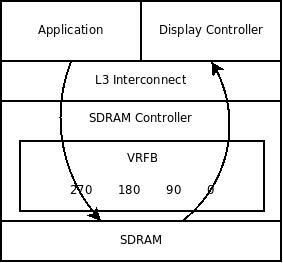Without hardware support for screen rotation the programmer is often left to rotate the content in software before it is placed into the frame buffer. This has a considerable impact on the performance of the product. An alternative on some devices is to use DMA to do the screen rotation. This requires the DMA engine to increment the SDRAM row between pixel reads and while it frees up the processor, it uses the SDRAM very inefficiently and can have similar performance impacts as doing the entire job in software. The OMAP3530 contains hardware support for screen rotation using a rotation engine called the Virtual Rotated Frame Buffer (VRFB). This is embedded into the SDRAM Controller and can be configured to issue multiple requests to the SDRAM ensuring a maximum of consecutive accesses is performed. By tuning the VRFB to the architecture of the SDRAM the impact of page-miss penalties can be decreased and accordingly memory access performance is improved. For the programmer the VRFB provides four virtual frame buffers; 0, 90, 180 and 270 degrees. Normally the display controller is programmed to read from the unrotated location and the content to be displayed is written to the virtual address of the required rotation.  We have recently implemented this feature in our Snapper-DV product. By using the combination of hardware rotation and hardware scaling the customer can pick and choose how their content is displayed on a variety of screens.
We have recently implemented this feature in our Snapper-DV product. By using the combination of hardware rotation and hardware scaling the customer can pick and choose how their content is displayed on a variety of screens.

OMAP: Virtual Rotated Frame BufferPosted in Uncategorized on January 28, 2009 by Administrator |



